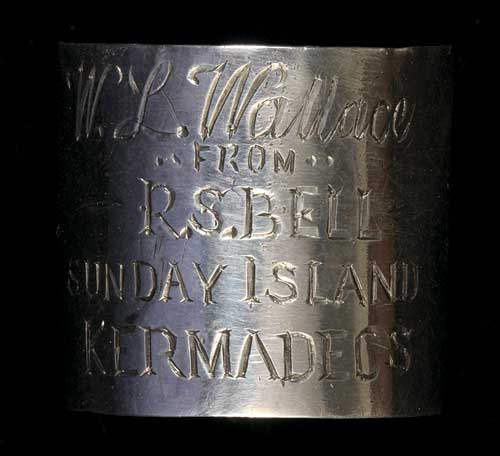New Zealand
Lot 849 SESSION 4 (4.30PM TUESDAY 2ND APRIL New Zealand
Estimate $200
Bid at live.noble.com.au
SOLD $220
PRESENTATION CANE MOUNT, undated, in silver (24mm diameter, 22mm high), two holes on one side for affixing to cane and on the other side is inscribed, 'W.L.Wallace/from/R.S.Bell/Sunday Island/Kermadecs'. Good very fine, historic and unique.
Raoul (Roy) Sunday Bell was born 19 February 1882 on Sunday (Raoul) Island, the largest of the Kermadec Islands. His parents had moved there in December 1878 from New Zealand. His father, Thomas Bell, had dreams of claiming Sunday Island as his own after farming and occupying it for several years but with the impending colonisation by Germany, the New Zealand Government requested Britain to lay claim to the island. They did this on 31 July 1886 and despite the protests by Thomas Bell, who laid claim to the island, the Kermadacs became part of the British Empire. He was allocated some land on the island to farm and despite claims of his title to the island due to his pioneering efforts and many legal appeals over the course of several years, his claim was never recognised.
Roy Bell went on to become a scientific collector for Gregory Matthews, an author of Birds of Australasia, from c1910 and took up residence at Norfolk Island. He served in WWI listing his birthplace as Sunday Island and his occupation as a taxidermist. Part of his service included time as 2/Air Mechanic with 3 Sqn Australian Flying Corps from March 1917. On his return to Australia in January 1919 he was discharged as medically unfit. He served again in WWII enlisting on 13 December 1941 at Norfolk Island with the stated occupation of photographer. He served with the Norfolk Island Infantry Detachment until discharged on 19 March 1942 as medically unfit. One of Roy's photographs of Ball Bay was used on the first issue of Norfolk Island stamps. He died on 28 March 1966 at Norfolk Island.
W.L.Wallace was born in Tasmania and later moved to New Zealand. He became friends with Roy Bell after they met when Wallace served on the 1908 Kermadec Islands Expedition. During this expedition, Wallace discovered on Raoul Island a rare Saprosites Raoulensis, a species of dung beatle endemic to the Kermadecs. This specimen he collected is held at the Auckland Museum.
Together with extensive research including military service records for Roy Bell.
Estimate / sale price does not include buyer's premium (currently 22% including GST) which is added to hammer price. All bids are executed on the understanding that the Terms & Conditions of sale have been read and accepted. For information on grading and estimates please refer to the Buying at Auction advice.
Quick find
View a lot by number and sale.
Adjacent lots
Lot 847
ROYAL HUMANE SOCIETY OF NEW ZEALAND SILVER MEDAL, (1913), type 2 (O&D.126), with suspender, reverse ...
Estimate $800
Lot 848
ROYAL HUMANE SOCIETY OF NEW ZEALAND BRONZE MEDAL, (1967), type 2 (O&D.126), with ribbon brooch ...
Estimate $500
Lot 849 This lot
PRESENTATION CANE MOUNT, undated, in silver (24mm diameter, 22mm high), two holes on one side ...
Estimate $200
Lot 850
EDWARD VIII, 50th Anniversary of Abdication, 1986, in aluminium, gilt aluminium, coppered aluminium, antiqued bronze, ...
Estimate $50
Lot 851
ANDERSON'S, D., Wellington halfpenny, undated (A.10). Edge bumps, otherwise good very fine.
Estimate $200
